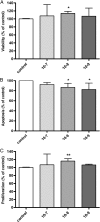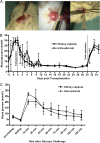Transplantation of pancreatic islets to adrenal gland is promoted by agonists of growth-hormone-releasing hormone
- PMID: 23345449
- PMCID: PMC3568317
- DOI: 10.1073/pnas.1221505110
Transplantation of pancreatic islets to adrenal gland is promoted by agonists of growth-hormone-releasing hormone
Abstract
Here, we evaluate an alternative approach of preconditioning pancreatic islets before transplantation using a potent agonist of growth-hormone-releasing hormone (GHRH) to promote islet viability and function, and we explore the adrenal gland as an alternative transplantation site for islet engraftment. The endocrine microenvironment of the adrenal represents a promising niche with the unique advantages of exceptional high oxygen tension and local anti-inflammatory and immunosuppressive properties. GHRH agonists have been shown to promote islet graft survival and function, which may help to reduce the islet mass necessary to reverse diabetes. In the present study, the most potent GHRH agonist MR403 was tested on insulinoma cells, isolated rat islets, and adrenal β-cell cocultures in vitro. GHRH receptor is expressed on both adrenal cells and islets. MR403 caused a significant increase in cell viability and proliferation and revealed an antiapoptotic effect on insulinoma cells. Viability of rat islets was increased after treatment with the agonist and in coculture with adrenal cells. Rat islets were transplanted into diabetic mice to the intraadrenal transplant site and compared with the classical transplants underneath the kidney capsule. Graft function and integration were tested by metabolic follow-up and immunohistochemical staining of intraadrenal grafts. A rapid decrease occurred in blood glucose levels in both models, and all animals reached normoglycemia within the first days after transplantation. Our studies demonstrated that the adrenal may be an attractive site for islet transplantation and that GHRH analogs might allow reduction of the islet mass needed to reverse a diabetic status.
Conflict of interest statement
The authors declare no conflict of interest.
Figures





Similar articles
-
Agonist of growth hormone-releasing hormone as a potential effector for survival and proliferation of pancreatic islets.Proc Natl Acad Sci U S A. 2010 Jul 13;107(28):12623-8. doi: 10.1073/pnas.1005098107. Epub 2010 Jun 28. Proc Natl Acad Sci U S A. 2010. PMID: 20616039 Free PMC article.
-
Modulation of pancreatic islets-stress axis by hypothalamic releasing hormones and 11beta-hydroxysteroid dehydrogenase.Proc Natl Acad Sci U S A. 2011 Aug 16;108(33):13722-7. doi: 10.1073/pnas.1110965108. Epub 2011 Aug 8. Proc Natl Acad Sci U S A. 2011. PMID: 21825133 Free PMC article.
-
Neural crest stem cells increase beta cell proliferation and improve islet function in co-transplanted murine pancreatic islets.Diabetologia. 2009 Dec;52(12):2594-601. doi: 10.1007/s00125-009-1544-z. Epub 2009 Oct 13. Diabetologia. 2009. PMID: 19823803
-
Actions and Potential Therapeutic Applications of Growth Hormone-Releasing Hormone Agonists.Endocrinology. 2019 Jul 1;160(7):1600-1612. doi: 10.1210/en.2019-00111. Endocrinology. 2019. PMID: 31070727 Review.
-
Growth hormone-releasing hormone: extrapituitary effects in physiology and pathology.Cell Cycle. 2010 Oct 15;9(20):4110-6. doi: 10.4161/cc.9.20.13787. Epub 2010 Oct 27. Cell Cycle. 2010. PMID: 20962577 Review.
Cited by
-
Profound Actions of an Agonist of Growth Hormone-Releasing Hormone on Angiogenic Therapy by Mesenchymal Stem Cells.Arterioscler Thromb Vasc Biol. 2016 Apr;36(4):663-672. doi: 10.1161/ATVBAHA.116.307126. Epub 2016 Feb 11. Arterioscler Thromb Vasc Biol. 2016. PMID: 26868211 Free PMC article.
-
Growth Hormone-Releasing Hormone and Its Analogues: Significance for MSCs-Mediated Angiogenesis.Stem Cells Int. 2016;2016:8737589. doi: 10.1155/2016/8737589. Epub 2016 Sep 27. Stem Cells Int. 2016. PMID: 27774107 Free PMC article. Review.
-
Agonists of growth hormone-releasing hormone stimulate self-renewal of cardiac stem cells and promote their survival.Proc Natl Acad Sci U S A. 2014 Dec 2;111(48):17260-5. doi: 10.1073/pnas.1420375111. Epub 2014 Nov 17. Proc Natl Acad Sci U S A. 2014. PMID: 25404316 Free PMC article.
-
Ciclopirox enhances pancreatic islet health by modulating the unfolded protein response in diabetes.Pflugers Arch. 2016 Nov;468(11-12):1957-1968. doi: 10.1007/s00424-016-1887-5. Epub 2016 Oct 19. Pflugers Arch. 2016. PMID: 27757583 Free PMC article.
-
Synthesis of new potent agonistic analogs of growth hormone-releasing hormone (GHRH) and evaluation of their endocrine and cardiac activities.Peptides. 2014 Feb;52:104-12. doi: 10.1016/j.peptides.2013.12.010. Epub 2013 Dec 25. Peptides. 2014. PMID: 24373935 Free PMC article.
References
-
- CITR Research Group 2007 update on allogeneic islet transplantation from the Collaborative Islet Transplant Registry (CITR) Cell Transplant. 2009;18(7):753–767. - PubMed
-
- Shapiro AM, et al. International trial of the Edmonton protocol for islet transplantation. N Engl J Med. 2006;355(13):1318–1330. - PubMed
Publication types
MeSH terms
Substances
LinkOut - more resources
Full Text Sources
Other Literature Sources
Medical

